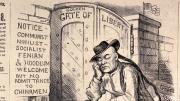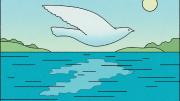Yiddish was born in the Rhineland more than 900 years ago. A fusion of about 80 percent German and 20 percent Hebrew, it also has incorporated many words from the Romance and Slavic languages, and, in the last hundred years, from English.
Max Weinreich, in his History of the Yiddish Language, constructs a model sentence comprising the four main components: Nokhn bentshn hot der zeyde gekoyft a seyfer [Following the benediction after the meal, grandfather bought a religious book]. Bentshn (cf. benedictere) is from loez, a term Weinreich uses to designate the Jewish correlates of Old French and Old Italian; seyfer from the Hebrew; nokhn, hot, der, gekoyftfrom the German; zeyde from the Slavic. Yiddish lettering consists of the twenty-two letters of the Hebrew alphabet, and is read, like Hebrew, from right to left.
Yiddish is a mirror of the total Jewish condition of the last 2,000 years. As Maurice Samuel presents the history in his 1971 work In Praise of Yiddish, it is an "exile" language, one of the many that Jews have fashioned in various lands and ages in their dispersions since the destruction of the First Temple in Jerusalem, in 586 b.c.e. Before that first, Babylonian, dispersion, the Jews spoke what we think of as biblical Hebrew.
Wherever Jews have lived, they have remodeled for intramural use the local language, adapting it to their needs and seasoning it with the ever-persistent Hebrew. Even in that first exile period, those who returned from Babylonia had learned to fuse Hebrew with its sister language, Aramaic; today what we call Hebrew is often, strictly speaking, Hebrew-Aramaic.
In similar fashion, Jews of Persia spoke a Judeo-Persian, and since then there have been, among others, Judeo-Arabic, Judeo-French, Judeo-Spanish (also known as Ladino or, more scientifically, Dzhudezmo). But Yiddish was, by far, the most important of all the Jewish vernacular languages, at the peak of its momentum spoken by some 11 million people, the only common language spoken by Jews on all five continents, and the one that produced the most extensive literature.
But for a long time, the "jargon" lacked respect. Learned Jews looked down on Yiddish, but basically could not get along without it. Hebrew was for prayer, study of sacred literature, and written communication with other learned Jews. Business accounts might be kept in Hebrew by those with a sufficient command of the language, but oral communication with other Jews was in Yiddish, even among the elite. When the same intellectuals wanted to find a general readership, they, too, had to utilize written Yiddish. In time, many highbrows found they had developed a profound affection for the demotic "jargon."





